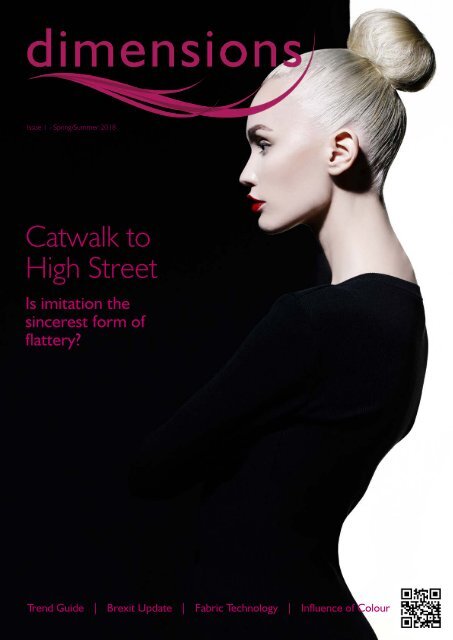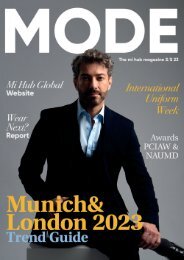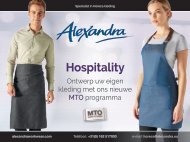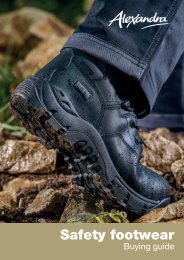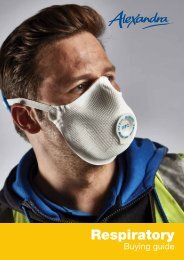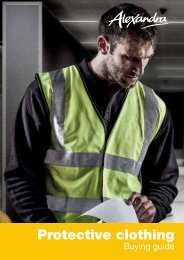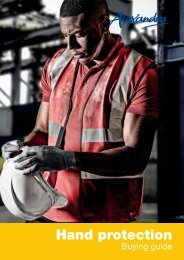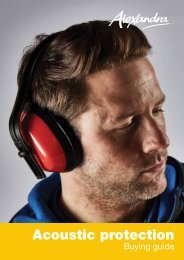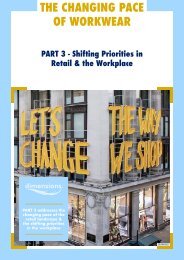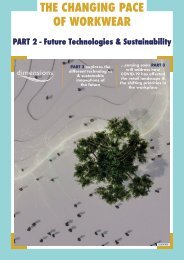Magazine - SpringSummer Issue 1
in Issue 1 of the Dimensions Magazine our designers have been out and about internationally to bring you the Trend Guide where you will find insights into what is up and coming in the fashion world. GDPR is this year’s buzzword and as the legislation came into force on 25th May, we’ve put together a guide of how we protect your data. Following on from the success of our Future of Work conference, we have invited behavioural economist Roger Martin-Fagg to provide you with an updated view of the Economic Outlook
in Issue 1 of the Dimensions Magazine our designers have been out and about internationally to bring you the Trend Guide where you will find insights into what is up and coming in the fashion world. GDPR is this year’s buzzword and as the legislation came into force on 25th May, we’ve put together a guide of how we protect your data. Following on from the success of our Future of Work conference, we have invited behavioural economist Roger Martin-Fagg to provide you with an updated view of the Economic Outlook
Create successful ePaper yourself
Turn your PDF publications into a flip-book with our unique Google optimized e-Paper software.
<strong>Issue</strong> 1 - Spring/Summer 2018<br />
Catwalk to<br />
High Street<br />
Is imitation the<br />
sincerest form of<br />
flattery?<br />
Trend Guide | Brexit Update | Fabric Technology | Influence of Colour<br />
1 dimensions.co.uk Spring/Summer 2018
Contents<br />
4 The Power of a<br />
Branded Uniform<br />
Catwalk<br />
to High<br />
Street<br />
20 Fibre Guide<br />
8 Why You Need<br />
To Know The<br />
Real Cost Of Your<br />
Uniform<br />
6<br />
18<br />
50 The Influence of<br />
Colour<br />
10 Recycle, Reuse,<br />
Refurbish<br />
Contributor:<br />
Christy Raedeke<br />
52 Multi-site Global<br />
Sourcing<br />
13 The Relationship Between<br />
Looking Good and Giving<br />
Great Customer<br />
Service<br />
17 GDPR:<br />
Protecting Your<br />
Data<br />
Contributor:<br />
Roger Martin-Fagg<br />
14<br />
21<br />
54 Giving<br />
Something Back<br />
55 Digital<br />
Technology<br />
Leaders Award<br />
2 dimensions.co.uk Spring/Summer 2018
Welcometo Spring/Summer<br />
edition<br />
I’m delighted to welcome you to the first edition of Dimensions’ eponymous biannual<br />
magazine. Dimensions always strives to be an industry leader and we have<br />
launched this magazine so we can share our knowledge with the people that really<br />
matter, you.<br />
Our designers have been out and about internationally to bring you the Trend<br />
Guide (page 21) where you will find insights into what is up and coming in the<br />
fashion world.<br />
GDPR is this year’s buzzword and as the legislation came into force on<br />
25th May, we’ve put together a guide of how we protect your data on<br />
page 17.<br />
Following on from the success of our Future of Work conference, we<br />
have invited behavioural economist Roger Martin-Fagg to provide you<br />
with an updated view of the Economic Outlook for 2018 (page 14).<br />
We really hope you enjoy our inaugural issue. Of course, if you have any questions,<br />
or simply want to get in touch, our contact details are at the bottom of this page.<br />
Hayley Brooks<br />
Managing Director<br />
Dimensions (MWUK Ltd) @dimensions_mwuk dimensions_mwuk<br />
web: www.dimensions.co.uk tel: +44 (0)1332 856 800 email: hello@dimensions.co.uk<br />
Spring/Summer 2018 dimensions.co.uk 3
The Power of a<br />
Branded Uniform<br />
A branded uniform is more than<br />
the clothes your employees wear<br />
on a day to day basis, it’s a walking<br />
billboard, a symbol of trust and a<br />
hint towards your professionalism<br />
and company standards.<br />
A branded uniform serves as<br />
a key marketing tool for brand<br />
awareness. Imagine all the places<br />
your employees go in a day, the<br />
drive through for breakfast, the deli<br />
at lunch, the petrol station after<br />
work, the supermarket, the gym…<br />
The possibilities for your brand to<br />
be exposed are limitless. As many<br />
of our clients have found out, a roll<br />
out of a new uniform has brilliant<br />
PR potential and can lead to massive<br />
exposure.<br />
Have you ever been in a shop<br />
and needed to ask a question but<br />
not known who works there, and<br />
walked back out? Chances are, if<br />
your staff don’t wear a uniform,<br />
your customers have too! Missed<br />
sales from missed opportunities are<br />
impacting your businesses’ bottom<br />
line. By identifying your members<br />
of staff clearly, customers are aware<br />
of who they can speak to with a<br />
query, this increased number of<br />
leads mean more opportunity for<br />
sales. At all costs, avoid putting your<br />
customers in the situation where<br />
they ask another customer if they<br />
work there!<br />
Would you let a stranger into your<br />
home? How would you feel about<br />
taking an unexpected parcel from a<br />
stranger in casual clothes? Chances<br />
are, you wouldn’t, and you wouldn’t<br />
feel comfortable. Having a uniform<br />
clearly identifies your workers, and<br />
puts customers at ease with having<br />
them in their home. A well branded<br />
uniform generates a feeling of trust,<br />
allowing your staff to do their jobs<br />
with no hassle. Without a uniform,<br />
your business looks unprofessional<br />
at best, and completely illegitimate<br />
at worse.<br />
4 dimensions.co.uk Spring/Summer 2018
We’ve established that a uniform is essential for your customers, but what about your staff?<br />
Working in a uniform presents a united front for your staff, and if your uniform is altered for different levels of<br />
seniority it makes an attractive reward for promotions. A world class, well-fitting uniform makes your staff feel<br />
valued, that you as an employer care enough about your employees to provide them with a quality uniform speaks<br />
volumes about you, and your company.<br />
What you might not<br />
know about us…<br />
We dispatched<br />
18.4 million<br />
items in 2017:<br />
CLAIM YOUR FREE<br />
DESIGN<br />
CONSULTATION<br />
SIMPLY CALL US ON 01332 697045<br />
AND QUOTE THE CODE “MAGAZINE01”<br />
Spring/Summer 2018 dimensions.co.uk 5
6 dimensions.co.uk Spring/Summer 2018
Christy Raedeke discusses<br />
“How a Fabric Technology<br />
Used by Pro Athletes Can<br />
Improve Your Uniforms”<br />
Did you know that the fabric<br />
technology that pro athletes<br />
use in hockey, cycling, running,<br />
football, and climbing is available<br />
in uniforms through Dimensions?<br />
Now the same fabric technology<br />
that helped this Salomon athlete<br />
shatter a Fastest Known Time in<br />
a recent ultramarathon can be<br />
incorporated into polos, suits,<br />
pants, jackets, and more. To put<br />
37.5 technology to the test in<br />
suiting, Carl Gross had a runner<br />
take on the Hamburg marathon<br />
in a 37.5 dress shirt and suit. The<br />
result? He broke the previous<br />
record for running in a suit by more<br />
than 15 minutes and is now in the<br />
Guinness Book of World Records.<br />
Your employees may not be<br />
running marathons, but in addition<br />
to increasing athlete efficiency, 37.5<br />
technology has been proven to<br />
increase comfort. 37.5 works in<br />
the vapor stage, moving moisture<br />
out of clothing before liquid sweat<br />
can form. As a broad concept, you<br />
can think of 37.5 clothing like the<br />
climate control in your car. You set<br />
it to the temperature at which your<br />
body is most comfortable and if it<br />
gets warmer, the air conditioner<br />
kicks on. If it gets colder, the heat<br />
kicks on. What a perk to your staff<br />
to show them that their comfort<br />
and performance is important<br />
enough for you to choose the<br />
finest thermoregulating fabric<br />
technology available for their<br />
uniforms! This is same technology<br />
they might find in their Adidas<br />
jacket, their Rossignol ski gear, or<br />
their Rip Curl snowboarding suit.<br />
How does 37.5 technology work?<br />
37.5 technology is reactive—<br />
it works with your body to<br />
determine if you need warming<br />
or cooling. 37.5 particles absorb<br />
the infrared (IR) energy your body<br />
emits and if moisture/sweat is<br />
present it speeds the evaporation<br />
to cool you. If no moisture/sweat<br />
is present, the IR energy is retained<br />
to keep you warm.<br />
How does this impact comfort?<br />
When moisture is removed from<br />
clothing, you stay warmer when it’s<br />
cool and cooler when it’s warm,<br />
widening your range of comfort in<br />
different temperatures and activity<br />
levels. This means you need fewer<br />
garments to serve a wider range of<br />
conditions.<br />
How does it increase<br />
performance?<br />
37.5 has been shown to increase<br />
athlete efficiency, as published in<br />
the International Journal of Sports<br />
Medicine (Jan 2017). When your<br />
body is not spending resources<br />
cooling or warming itself, it is more<br />
efficient. You have more stamina.<br />
Whether you are cycling in the<br />
Tour de France or standing behind<br />
a desk greeting guests all day, how<br />
much your body has to work to<br />
cool or warm itself impacts your<br />
work.<br />
How long will it last?<br />
37.5 technology offers a natural,<br />
permanent technology that will<br />
last the lifetime of the garment. It’s<br />
not a chemical finish; the natural<br />
particles are embedded in the yarns<br />
or fibers that make up the garment<br />
and will never wash out.<br />
If you’d like to discuss how<br />
you can incorporate 37.5<br />
technology into your uniform,<br />
contact 01332 856800 or email<br />
hello@dimensions.co.uk<br />
What you might not know<br />
about us…<br />
We dress over 4 million<br />
people - approximately 13%<br />
of the UK's workforce.<br />
Spring/Summer 2018 dimensions.co.uk 7
Why You Need To Know<br />
The Real Cost Of Your Uniform<br />
In the battle for the lowest cost corporate clothing, the<br />
ethical considerations of global manufacturing can sometimes<br />
be overlooked by purchasers. The perceived view of the<br />
garment industry and the challenges often associated with<br />
manufacturing on such a large scale include child labour,<br />
low wages and sweatshop conditions, so taking ethical<br />
considerations into account are a must when choosing a<br />
garment supplier.<br />
Following our recent online guide on ‘the multi-site global<br />
considerations when choosing suppliers’, here we give an<br />
in-depth view of the importance of ethical compliance within<br />
the supply chain.<br />
We recognise the obvious benefits for our<br />
clients of overseas sourcing of fabric and<br />
garments, and we are extremely conscious<br />
of the potential social impacts that overseas<br />
sourcing can have.<br />
To ensure strict continuous improvement, both external<br />
auditors and our own staff constantly monitor our facilities.<br />
We aim to educate and build capability with our facilities to<br />
ensure that compliance to high standards becomes habitual<br />
and they understand the benefits that compliance has on<br />
their facility.<br />
The team at Dimensions complete walkthroughs and audits<br />
of a facility whenever they visit; this allows us to assess<br />
general health and safety elements in the facility, and provide<br />
actions where improvement is needed.<br />
ETI and SEDEX<br />
Here at Dimensions, we place ethical trading at the heart of<br />
our business, our commitment to this was recognised when<br />
we gained membership to both the Ethical Trading Initiative<br />
and SEDEX. Dimensions became a member of the Ethical<br />
Trading Initiative in 2007 and<br />
consequently we adopted the<br />
internationally recognised ETI Base<br />
Code of Labour Practice. We are<br />
committed to supporting our suppliers<br />
to implement this code of practice, and<br />
as a result help to create a fair and safe<br />
working environment for their employees.<br />
8 dimensions.co.uk Spring/Summer 2018
This is part of our continuous improvement plan to improve<br />
working conditions, create environmentally friendly work<br />
places and uphold all human rights.<br />
ETI BASE CODE:<br />
• Freedom of association and the right to collective<br />
bargaining are respected<br />
• Working conditions are safe and hygienic<br />
• Child labour shall not be used<br />
• Living wages are paid<br />
• Working hours are not excessive<br />
• No discrimination is practiced<br />
• Regular employment is provided<br />
• No harsh or inhumane treatment is allowed<br />
• Employment is freely chosen<br />
Dimensions joined the Supplier Ethical Data Exchange<br />
(SEDEX) in 2008 and we continually monitor our supply<br />
chain and submit the relevant information into their database.<br />
SEDEX aims to provide a secure database for companies<br />
to store and share ethical data. This allows us to link the<br />
supplier data to the customer enabling transparency in our<br />
supply chain.<br />
It’s very important to Dimensions that our workforce is<br />
also aware of our ethical trading values and what they stand<br />
for. Our membership to organisations are represented at<br />
Director level within Dimensions. Our staff, and indeed<br />
some of our clients have attended training and workshops<br />
with trade associations in order to share best practice and<br />
learn from other members.<br />
Purchasers that do not take ethical considerations into<br />
consideration when choosing their suppliers are putting their<br />
brand reputation at risk. Consumers are increasingly aware<br />
of the ethical cost of global sourcing, and are putting higher<br />
value on ethical practices and the brands that show their<br />
dedication to ethical trading.<br />
We are dedicated to achieving best possible practices and<br />
services. As brand guardians for major companies, we<br />
dedicate ourselves to ethical practices within our supply chain<br />
so our clients can buy with confidence. We hold ourselves<br />
accountable to the highest industry standards, and you can<br />
be assured of total transparency.<br />
In our next issue, we will look at<br />
how the HERProject unlocks the<br />
full potential of women working<br />
in global supply chains through<br />
workplace-based interventions<br />
on health, financial inclusion, and<br />
gender equality.<br />
Spring/Summer 2018 dimensions.co.uk 9
Recycle<br />
Reuse<br />
Refurbish<br />
10 dimensions.co.uk Spring/Summer 2018
Avoiding Landfill at the End of the Product Life Cycle<br />
The Office for National Statistics<br />
states that at the end of 2016, 32<br />
million people were working in the<br />
UK; many of whom will have worn<br />
some form of corporate clothing<br />
provided by their employer, whether<br />
that be work wear, career wear,<br />
corporate casual wear or a uniform.<br />
With the average product life cycle for<br />
corporate clothing being between 1-2<br />
years, this means that approximately<br />
10,000 tonnes is accumulated in<br />
corporate clothing waste in the UK<br />
each year. Whilst almost 10% of<br />
this is recycled or reused effectively,<br />
the remaining 90% goes to landfill<br />
or is incinerated. This could have a<br />
detrimental effect on the environment<br />
if changes are not made quickly. Of<br />
course we aren’t suggesting that<br />
organisations alleviate the problem by<br />
not providing corporate clothing, as<br />
that would present new problems in<br />
itself. We do, however, need to look<br />
at how the issue is being addressed by<br />
employers, in partnership with their<br />
corporate clothing suppliers.<br />
Last year, Dimensions<br />
provided corporate<br />
clothing for over 4<br />
million people in the UK,<br />
approximately 13% of the<br />
working population<br />
We recognise our obligations to<br />
care for the environment through<br />
the prevention of pollution, and the<br />
implementation and monitoring of<br />
good environmental practices. We<br />
strive to maintain best practices,<br />
seeking continuous improvement and<br />
innovation through our accreditation<br />
of BS EN ISO 14001 Environmental<br />
Management System. This includes<br />
how we deal with our clients’ clothing<br />
at the end of their life cycles.<br />
Disposal of stock also forms part of our<br />
Quality Management System, ISO9001.<br />
All fabric and trims are ordered in<br />
line with required demand and any<br />
unusable product is securely disposed<br />
of in an environmentally friendly<br />
method.<br />
Why isn’t the majority of corporate<br />
clothing recycled?<br />
There are three main reasons why<br />
the majority of corporate clothing is<br />
currently sent to landfill rather than<br />
recycled, those being:<br />
1) Many uniforms are produced<br />
by blending fibres. This makes the<br />
garments difficult to recycle, as<br />
technologies for separating fibres are<br />
not commercially available yet<br />
2) Security, branding and corporate<br />
image are big issues for corporate<br />
clothing disposal<br />
3) Because of point 2, it can be difficult<br />
to find out which recycling companies<br />
will accept corporate wear, as there are<br />
a lot of rules and regulations about how<br />
garments should be dealt with.<br />
In the past, the recycling of clothing<br />
waste has relied on the value of the<br />
garments. Higher quality clothing<br />
has typically been sold in the UK via<br />
the charity sector, or for export to<br />
developing countries, whilst lower<br />
quality clothing has been disposed of.<br />
However, many organisations now<br />
demand a secure and audited process<br />
for handling items with their corporate<br />
name or logo on, in order to retain<br />
control of how and where their<br />
branding is seen, which has made them<br />
less suitable for export. This means only<br />
garments that are not heavily branded<br />
can be sent to charities in developing<br />
countries.<br />
In the first instance, our preferred<br />
method of corporate clothing disposal is<br />
the garment refurbishment scheme.<br />
What is garment refurbishment?<br />
As the originator of the garment<br />
refurbishment scheme in the corporate<br />
clothing industry, we work with<br />
clients on the environmental disposal<br />
of used garments from the wearer<br />
base. This generates substantial cost<br />
savings for clients, as well as significant<br />
environmental benefits. Uniforms from<br />
departing staff that are returned for<br />
recycling, are graded against pre-agreed<br />
standards before being professionally<br />
cleaned, repacked and returned to<br />
stock.<br />
The refurbished items can be identified<br />
separately to allow re-issue to existing<br />
wearers. In addition to the cost<br />
savings generated, this scheme helps<br />
to reduce the amount of stock held at<br />
each location and ensures that all new<br />
starters are issued with a clean and<br />
properly presented uniform.<br />
What if garments are not suitable for<br />
refurbishment?<br />
If returned products cannot be<br />
refurbished, garments can be securely<br />
disposed of by being shredded and<br />
baled, before being flocked for<br />
utilisation in products such as car<br />
upholstery. They can also be used in<br />
the wiper/cloth industry, or sent to<br />
a recycling plant where the garment<br />
waste is turned into shoddy, which<br />
is then used to produce blankets for<br />
distribution into disaster areas.<br />
The recycling agent that we partner<br />
with established a list of garments<br />
that are suitable for a new grade<br />
of processed waste called Waste<br />
Processed Fibre (WPF). This can be<br />
used in a number of applications,<br />
including mattress fillings, felts, sound<br />
insulation and heat insulation. The list<br />
includes the vast majority of corporate<br />
clothing, including work wear, fleeces,<br />
catering clothing and accessories, such<br />
as socks, ties and gloves.<br />
Spring/Summer 2018 dimensions.co.uk 11
In the past, only fibres which are<br />
inherently Fire Retardant (FR) such as<br />
wool, could be used in mattress pads.<br />
Now, the Waste Processed Fibre (WPF)<br />
is shipped to mills and treated with a<br />
range of synthetic resins, which ensure<br />
that the fibre conforms to FR2 and FR1<br />
standards. WPF can also be thermally<br />
bonded with nylon waste, generated<br />
from the manufacture of other<br />
products, including carpet tiles. The<br />
more nylon waste used, the more rigid<br />
the end product is. This means that<br />
it can be used for products including<br />
packaging, internal walls and concrete<br />
shuttering.<br />
Can they be recycled into other<br />
corporate apparel?<br />
We have an exclusive partnership in<br />
the corporate wear market to provide<br />
sustainable solutions for corporate<br />
textile waste by ‘up-cycling’ reusable<br />
materials into new, design-led products.<br />
For example, we have recently started<br />
transforming redundant high-visibility<br />
jackets into bags and mail sleeves. This<br />
provides an excellent alternative to<br />
sending those products to landfill and<br />
could bring potential cost savings to the<br />
client.<br />
A further area of up-cycling involves<br />
one of our suppliers who, in<br />
partnership with us, has pioneered<br />
a scheme which harnesses modern<br />
technology to produce fibres,<br />
fabrics and clothing with minimal<br />
environmental impact.<br />
This initiative starts with the collection<br />
of 100% virgin cotton surplus scraps,<br />
unused waste fibres and fabrics from<br />
cutting rooms. This is converted back<br />
into yarn and then blended and knitted<br />
with regenerated 100% polyester<br />
made from PET plastic bottles to<br />
produce knitted pique fabric. Once the<br />
fabric is knitted, it is then washed and<br />
finished to be manufactured into polo<br />
shirts without dyeing the fabric again.<br />
Our supplier of the dyed polyester has<br />
the Global Recycle Standard Certificate<br />
for added reliability.<br />
These processes are supported by<br />
the use of efficient recycled energy to<br />
further reduce emission levels.<br />
What about footwear?<br />
Quality, paired shoes are generally in<br />
limited supply, as people tend to wear<br />
practical footwear such as trainers or<br />
work shoes until they are no longer<br />
fit for use. Fashion shoes are an<br />
exception to this, however they are<br />
not practical for recycling or reuse in<br />
the countries which shoes would be<br />
sent to. The footwear that we recycle<br />
can be redistributed all across Europe,<br />
however, the end uses for serviceable<br />
shoes and boots can vary. Trainers and<br />
lightweight shoes are typically shipped<br />
to different developing countries, as<br />
opposed to those who will accept<br />
heavier shoes and boots.<br />
Unserviceable or unpaired shoes have<br />
two end uses:<br />
- They are shredded and used in the<br />
Waste Derived Fuel product - this is<br />
normally the case for synthetic shoes<br />
- Unserviceable leather shoes (without<br />
steel toe caps) can be mixed with other<br />
leather waste such as handbags and<br />
belts, which is exported to developing<br />
countries. There, it is recycled into a<br />
reconstituted leather product.<br />
STEP 1<br />
100% cotton surplus scraps are<br />
collected from factory cutting rooms.<br />
STEP 2<br />
The cotton scraps are sorted into broad<br />
colour groups and analysed for shade.<br />
STEP 3<br />
The cotton<br />
scraps are<br />
shredded<br />
using<br />
specialist<br />
machinery<br />
STEP 5<br />
The shredded<br />
cotton scraps<br />
are blended with<br />
the regenerated<br />
polyester.<br />
Polyester<br />
STEP 4<br />
PET plastic<br />
bottles are<br />
supplied and regenerated<br />
to create 100% polyester.<br />
STEP 6<br />
The blended cotton<br />
and polyester is<br />
spun into yarn and<br />
knitted to produce<br />
authentic ecofriendly<br />
pique fabric.<br />
12 dimensions.co.uk Spring/Summer 2018
The Relationship Between<br />
Looking Good and Giving<br />
Great Customer Service<br />
At the start of the year, the Institute of Customer Service issued the UK Customer Satisfaction Index, which outlined<br />
the 50 top-scoring organisations for customer satisfaction in the UK. We’re proud to clothe many of the Top 50 on the<br />
list, especially as Customer Service is at the heart of everything we do. We believe that there is a strong relationship<br />
between looking good and giving great customer service, so we always make sure to focus on how we can enhance that<br />
relationship for our clients when creating a new corporate clothing range. Let’s discuss the link…<br />
What makes great customer service?<br />
The words that customers most frequently used to describe their experience with the Top 50 organisations, include:<br />
happy, helpful, professional, efficient and friendly. This means that organisations need to develop their ability to offer fast,<br />
knowledgeable and reliable expert service in order to maintain high customer satisfaction levels. So how can a uniform<br />
influence that?<br />
HAPPY<br />
It is a well-established thought that<br />
developing a co-ordinated uniform can<br />
boost self-esteem, which contributes<br />
to improving attitude and productivity.<br />
Consequently, the customer service given<br />
is of a higher quality. This is because looking<br />
good helps people to feel confident, happy<br />
and to maintain a positive outlook, which<br />
is crucial for staff when they are interacting<br />
with customers all day.<br />
PROFESSIONAL<br />
Looking good and feeling like part of a team also creates a united<br />
workforce with a combined sense of responsibility. It encourages<br />
colleagues to work professionally together in order to achieve<br />
established company targets. This inspires staff to perform better as<br />
they feel more appreciated as being part of a team and when staff<br />
feel appreciated, engagement is higher.<br />
The UKCSI showed a strong link between employee engagement<br />
and customer satisfaction, as well as evidence of the link between<br />
customer satisfaction and business performance 43% of customers<br />
will actively warn others against using an organisation that they have<br />
had a bad experience with.<br />
EFFICIENT<br />
On the other hand, if your uniform differentiates between teams or<br />
levels, it can make progression within your company an attractive<br />
prospect for staff, as they know that they will receive a new uniform<br />
to demonstrate their promotion. This means that they will feel<br />
motivated and willing to take on extra responsibilities, which in turn,<br />
will improve efficiency and business performance which will help the<br />
business to evolve and grow.<br />
HELPFUL<br />
When staff wear a uniform, it portrays<br />
a united brand image, which indicates<br />
to customers that they will receive a<br />
consistently good service level from all<br />
employees, no matter who they are<br />
served by. It makes staff more conscious<br />
of their actions and encourages them to<br />
act in a certain way, as they are easily<br />
identifiable to customers as working for<br />
the company. This instantly helps to build<br />
the trust between brand and customer<br />
as it gives the impression that staff are<br />
knowledgeable, approachable and ready<br />
to help – these are all key factors in<br />
providing fantastic customer service.<br />
FRIENDLY<br />
Rolling out an attractive new uniform can also get your<br />
brand in the press for all the right reasons and increase<br />
brand visibility. This can either be done via social media or<br />
traditional PR, by your staff sharing photos of themselves in their new uniform or by publications releasing them for you.<br />
This will generate excitement around your brand and encourage customers to purchase from you. If they see photos of<br />
your staff looking happy in their uniform, it gives the impression that your company offers positive and friendly service.<br />
Spring/Summer 2018 dimensions.co.uk 13
THE ECONOMIC<br />
Roger began his career as an Economist with the New Zealand Treasury in 1972, then as<br />
Economist to the Air Transport and Travel Industry Industrial Training Board. In 1976 he<br />
was asked to design and run a postgraduate programme in Airline Management for British<br />
Airways which ran successfully for 12 years at Thames Valley University.<br />
In 1987 he joined Henley Management College to design, deliver and teach bespoke<br />
strategic management programmes. This he did for 21 years covering all sectors, but with an<br />
emphasis on Financial Services, house builders and newly privatised Utilities.<br />
For the past nine years, Roger has worked as an Independent Behavioural Economist. He is<br />
visiting faculty at Warwick, Ashridge (where he teaches the MBA), Henley and Duke Business<br />
Schools. He has been an External Examiner at The University of Bath, and visiting faculty at<br />
the Bank of England and the Institute of Marketing.<br />
Roger Martin-Fagg BA HONS<br />
He specialises in making economics accessible for non-economists and helping boards think<br />
through their Strategy. He leads workshops, seminars, and delivers keynote sessions. He has worked in the USA, Middle<br />
East, Russia and SE Asia.<br />
His book Making Sense of the Economy is in its fourth reprint, and he publishes a quarterly economic update which is read by<br />
1200 Chief Executives.<br />
He has a reputation for making the complex simple, producing accurate forecasts, and is one of a few Economists with a keen<br />
sense of humour. He forecast the 2008 crash, Brexit and Trump!<br />
In his spare time he is a Veteran Oarsman at Marlow Rowing Club and plays keyboards in a Rock Band.<br />
This month, we chatted to Roger about his views of the economic outlook for 2018.<br />
The UK is underperforming the USA and the EU. The reasons are clear. For 86% of companies surveyed by the Bank of<br />
England the uncertainty around Brexit is affecting their investment plans. Looking ahead to 2020, 34% expect their investment<br />
spend to be 6% lower, 30% expect their investment to be 3% lower. But 36% expect their investment to be 14% higher. So<br />
64% of those surveyed are expecting to reduce their investment spend. This comes at a time of full employment: investment<br />
is needed to boost productivity and thus GDP per capita.<br />
14 dimensions.co.uk Spring/Summer 2018
OUTLOOK 2018<br />
The UK’s potential growth rate<br />
falls over the next two years<br />
It is encouraging to see IP investment rising: this covers spend<br />
on AI which is the main route to improved productivity. But UK<br />
business has underinvested since 2008. Consequently our national<br />
productivity growth is only growing at 0.8%. Taking demographics<br />
and net migration into account the Bank of England believe<br />
that our sustainable growth rate has dropped from 2.5%pa<br />
to 1.5%pa. They do not expect it to recover until a lot more<br />
productivity enhancing investment spending takes place.<br />
The UK is running at full employment of available resources even<br />
though our real output is growing at just 1.5%. It means that the<br />
growth in money supply has to be reduced to avoid inflation taking<br />
hold. This is why interest rates are beginning to rise. If people<br />
respond quickly to a small increase of say 0.5% ie new mortgages<br />
granted and retail credit slows, then further increases will be<br />
unnecessary and we can look forward to no increase beyond<br />
1.25%. However if there is a wage explosion (earnings growing at<br />
4%) then we can expect rates to rise beyond 1.25% in 2019-20.<br />
The good news is money supply data for March 2018 suggest an increase in interest rates can avoided until later in the year.<br />
Furthermore if money supply growth remains subdued then there will be no wage explosion. If we crash out of the EU in<br />
December 2020 then rates will be have to be cut back to 0.25% for a period to prevent supply chain disruption causing a full<br />
blown recession.But this will cause sterling to weaken and the result will be higher inflation and we will see repeat of the last<br />
two years. The Bank of England have a difficult balancing act to manage.The Prime Minister has made it clear we will leave the<br />
customs union and single market in Dec 2020. We will not have a bespoke deal in place by then. To avoid chaos we will have<br />
to extend the transition period.<br />
Crashing out of the EU will cause sterling to drop back to around $1.25 and 1.08 Euro thus boosting import prices and then<br />
CPI. And by 2022 real incomes will again fall as the chart shows happened after vote leave.<br />
Spring/Summer 2018 dimensions.co.uk 15
The Economic Outlook 2018 continued...<br />
It is clear the very cold weather experienced by the UK<br />
and Europe in March has reduced first quarter GDP<br />
growth in both areas. The UK only grew by 0.1% in real<br />
terms (we expected 0.3%). We should expect a significant<br />
improvement in Q2. And as real incomes grow from now<br />
retail sales should strengthen in the second half of this year.<br />
Looking further ahead the USA is close to the top of its<br />
economic cycle: interest rates will continue to rise in the<br />
USA over the next 18 months. In 2019 the USA will begin<br />
to slow. The EU has at least two years of growth ahead as<br />
it absorbs the spare capacity which exists (except Germany<br />
which is at full employment). The UK will continue to<br />
fudge the Brexit negotiations. I suspect the end game is an<br />
extension of the transition period beyond December 2020.<br />
This will allow Government to say we will leave but only<br />
when we can find a workable solution to the Irish border and<br />
find a customs system which will continue to allow frictionless<br />
trade with the EU. As we will continue to pay a subscription<br />
to the EU in the transition period I suspect the EU will be<br />
happy to continue the arrangement. They need the money!<br />
For UK business the main constraint on growth will be<br />
the right kind of employees. Good people will be in high<br />
demand. My advice is to develop and train your employees<br />
so they could leave at any time but create a working<br />
environment which encourages them to stay. Giving your<br />
employees the very best working conditions possible must<br />
be a priority.<br />
Household real incomes and consumption should<br />
pick up in the second half of 2018<br />
UK Retail sales trending downwards<br />
16 dimensions.co.uk Spring/Summer 2018
17 dimensions.co.uk Spring/Summer 2018
Catwalk<br />
to High<br />
Street:<br />
Is imitation the<br />
sincerest form<br />
of flattery?<br />
18 dimensions.co.uk Spring/Summer 2018
Over 300 years ago in 1714, English writer Eustace Budgell<br />
wrote in The Spectator that “Imitation is a kind of artless<br />
flattery”, a phrase which was then, ironically, revised by<br />
Charles Caleb Colton in the 19th century to be the nowfamous<br />
quote “Imitation is the sincerest form of flattery.”<br />
But, is imitation the sincerest form of flattery or is it simply<br />
seen as an unethical act of plagiarism?<br />
In many industries, protecting intellectual property rights has<br />
become big business, with more and more companies wanting<br />
to safeguard their valuable assets. However, in industries such<br />
as music and fashion, growth and creativity within the industry<br />
relies on imitation.<br />
We know that musicians and designers take inspiration from<br />
each other; in fact it is recognised that the high street is heavily<br />
influenced by the catwalks of London Fashion Week. So, when<br />
is imitation seen as inspiration or simply just copying?<br />
Reports suggest that many designers are keen for their ideas<br />
to be popularised and fashion houses are flattered when they<br />
see their designs re-interpreted on the high street. Indeed,<br />
in recent years designers have collaborated with high street<br />
retailers to create affordable versions of their own designs.<br />
To copy an individual or organisation is often an unintended<br />
complement and a great tribute to the success of those that<br />
are copied. In the corporate world, market leaders are often<br />
copied by smaller companies as it is natural that they aspire to<br />
be seen as successful in their field.<br />
However, unlike the fashion or music industry, within the<br />
business world, imitators rarely have the substance behind<br />
the style. Market leaders invest in research & development<br />
and innovation is at the forefront of their strategy; those who<br />
concentrate on copying seldom have the vision to focus on<br />
leading the field.<br />
As market leader within the UK corporate clothing industry,<br />
we strive to lead the way in innovation and service. Our<br />
technical garment and fabric developments are often first into<br />
our trading theatre and our IT developments are innovative<br />
and progressive in delivering customer service. When our<br />
clients tell us that our standards are the ones that they<br />
measure others against we are both flattered and honoured.<br />
After all, Coco Chanel said “if you want to be original, be<br />
ready to be copied!”<br />
“if you want to be<br />
original, be ready to<br />
be copied!<br />
- Coco Chanel<br />
Spring/Summer 2018 dimensions.co.uk 19
FIBRE GUIDE<br />
WOOL<br />
We currently use four main fibre types in our ranges<br />
COTTON<br />
Wool is a natural fibre, obtained predominantly from the fleece of<br />
sheep. The quality of wool can vary, depending on its source.<br />
Although wool is versatile, it is mainly used in our suiting fabrics, as it<br />
offers good abrasion resistance and natural moisture wicking.<br />
Beneficial properties:<br />
Due to its good abrasion resistance, wool is generally resistant to<br />
pilling. It has excellent absorbency and is breathable. Wool is a natural<br />
insulator, which means that it will help to keep the wearer warm or<br />
cool as required. Wool has a soft handle and is crease resistant.<br />
Care considerations:<br />
Wool shrinks easily and on its own, can be a relatively weak fibre,<br />
although dry cleaning can prevent shrinkage from occurring. It is<br />
expensive to process and difficult to wash and care for, compared<br />
to synthetic fibres.<br />
End of life possibilities:<br />
Wool is a natural fibre, so is biodegradable. It can also be recycled<br />
into insulation materials.<br />
POLYESTER<br />
Polyester is an oil-based synthetic fibre and is the most widely used<br />
of all the man-made fibres. As such, it is the most common fibre<br />
used in corporate wear, due to its durability and strength.<br />
Beneficial properties:<br />
Polyester is the best wash-and-wear fibre, in that it is easy care, shrink<br />
resistant and quick drying. It maintains good stability and excellent<br />
colour retention, as it is not damaged by sunlight or weather.<br />
Care considerations:<br />
Polyester is not very breathable and can have a shiny appearance,<br />
contributing to potential static build-up. It is also prone to pilling and<br />
snagging more than other fibres.<br />
End of life possibilities:<br />
In general, polyester is not biodegradable and therefore is not suitable<br />
for composting. However, polyester produced from recycled plastic<br />
bottles is now widely available.<br />
Cotton is a natural fibre, with a near-white matt or dull appearance.<br />
Due to its natural background, organic and “green” cotton are<br />
available, which can be supplied via Fairtrade or the Better Cotton<br />
Initiative.<br />
Cotton is used in a range of our garments, due to its soft handle and<br />
moisture regain properties.<br />
Beneficial properties:<br />
Due to its natural properties, cotton is non-allergenic. It is also<br />
breathable, maintains its strength when wet, and has good abrasion<br />
resistance. It produces no static build up.<br />
Care considerations:<br />
Cotton is prone to becoming creased and therefore requires more<br />
ironing than fabrics produced from other fibres. It can take a long<br />
time to dry naturally, or will need to be set to a high setting in a<br />
tumble dryer. Colour retention and shrinkage also tends to not be as<br />
good as synthetic fibres.<br />
End of life possibilities:<br />
Organic cotton is biodegradable, but it can also be reused. Cutting<br />
room waste can be recycled back into fibre form for re-use.<br />
VISCOSE<br />
Viscose is a regenerated cellulose fibre, which is strong, durable and<br />
comfortable. This makes it a key fibre to use in producing corporate<br />
wear, as clothes may be worn on a regular basis for up to 2 years.<br />
Beneficial properties:<br />
Viscose is abrasion resistant, yet soft to handle and has good drape<br />
properties. It is breathable and absorbent, which adds to its comfort.<br />
Care considerations:<br />
Viscose tends to be weak when wet and is prone to shrinking. Like<br />
polyester, viscose can pill and snag more easily than other fibres and<br />
can have a shiny appearance.<br />
End of life possibilities:<br />
As it is 100% cellulose, viscose is biodegradable. It also has potential<br />
for reuse and remanufacture and should not be sent to landfill.<br />
Blends of the above<br />
Blending two or more of the above fibres into one fabric, can result in combining the positive elements of a fibre while controlling the negative<br />
elements.<br />
Fabric types<br />
Woven:<br />
Woven fabrics are produced on a loom, by weaving two or more<br />
yarns at right angles. Warp yarns run parallel to the selvage, with<br />
weft yarns perpendicular to the selvage. There are four main weave<br />
structures commonly used, those being: plain weave, basket weave,<br />
twill weave and satin weave.<br />
Knitted:<br />
Unlike weaving, knitted fabrics can be produced with just one yarn, creating<br />
stitches that loop together to create the fabric. There are lots of varieties<br />
of knitted fabrics, but the main ones that we use are: single jersey, interlock<br />
and pique knits. Knitted fabrics are faster to produce than woven fabrics<br />
and the loop stitch construction makes knits softer than woven fabrics.<br />
20 dimensions.co.uk Spring/Summer 2018
21 dimensions.co.uk Spring/Summer 2018
22 dimensions.co.uk Spring/Summer 2018
23 dimensions.co.uk Spring/Summer 2018
24 dimensions.co.uk Spring/Summer 2018
25 dimensions.co.uk Spring/Summer 2018
26 dimensions.co.uk Spring/Summer 2018
27 dimensions.co.uk Spring/Summer 2018
28 dimensions.co.uk Spring/Summer 2018
29 dimensions.co.uk Spring/Summer 2018
30 dimensions.co.uk Spring/Summer 2018
31 dimensions.co.uk Spring/Summer 2018
32 dimensions.co.uk Spring/Summer 2018
33 dimensions.co.uk Spring/Summer 2018
34 dimensions.co.uk Spring/Summer 2018
35 dimensions.co.uk Spring/Summer 2018
36 dimensions.co.uk Spring/Summer 2018
37 dimensions.co.uk Spring/Summer 2018
38 dimensions.co.uk Spring/Summer 2018
39 dimensions.co.uk Spring/Summer 2018
40 dimensions.co.uk Spring/Summer 2018
41 dimensions.co.uk Spring/Summer 2018
42 dimensions.co.uk Spring/Summer 2018
43 dimensions.co.uk Spring/Summer 2018
44 dimensions.co.uk Spring/Summer 2018
45 dimensions.co.uk Spring/Summer 2018
46 dimensions.co.uk Spring/Summer 2018
47 dimensions.co.uk Spring/Summer 2018
48 dimensions.co.uk Spring/Summer 2018
Don’t miss our<br />
next issue...<br />
The Trend Guide<br />
Volume 3<br />
PPE: All You<br />
Need To Know<br />
Dimensions<br />
Celebrates<br />
30 Years<br />
Don’t forget to keep up to date<br />
www.dimensions.co.uk<br />
49 dimensions.co.uk Spring/Summer 2018
THE INFLUENCE OF COLOUR<br />
If an organisation brands itself effectively, it is not unusual for a colour to spring to mind instantly when someone<br />
mentions the brand’s name. It is for this reason that many companies choose to dress their staff in brightly<br />
coloured, distinguishable uniforms which will ensure that they stand out to customers – making them more<br />
approachable.<br />
However, beyond the initial recognition of the brand, it is interesting to study how different colours make us<br />
feel and the impressions that they create in people’s minds. Most of these feelings are evolutionary and have<br />
been developed or inherited over time, which means that whilst we can’t change the way that people will feel<br />
about certain colours, we can design uniforms around these formed associations to ensure that consumers will<br />
feel as positive as possible about your brand, before an interaction has even taken place.<br />
Here is a guideline of colour associations to consider when rebranding or redesigning your new uniform, to<br />
ensure that you are sending out an accurate message to your existing and potential customers.<br />
Whilst this advice has been formed on the basis of research, these are guidelines only. The most powerful<br />
uniforms will always be those that portray your brand ideals and values accurately.<br />
50 dimensions.co.uk Spring/Summer 2018
RED<br />
Red is most commonly associated with energy, power and confidence. It is a brilliant colour to wear<br />
if you need or want to attract attention, as it quickly stimulates emotions and encourages action. This<br />
makes it ideal for organisations that want to convey passion and positivity. Interestingly, red has also been<br />
shown to stimulate appetite, which makes it a smart colour to use in the hospitality and catering sectors<br />
– it is often seen in restaurants and fast food establishments.<br />
BLUE<br />
Blue is the most universally favoured colour and therefore makes it a stable colour to choose for a<br />
uniform which a lot of different people are going to see. The colour is known to symbolise trust, reliability<br />
and relaxation, making it a suitable colour for almost any organisation, as it is a universal goal to be seen<br />
as trustworthy and reliable in order to build a loyal customer base. However, it is a particularly suitable<br />
colour to use for uniforms within the finance, healthcare and trade industries.<br />
GREEN<br />
Often seen as the colour of nature, green is most commonly associated with things such as growth,<br />
vitality and the environment. It is therefore perfect for industries associated with the outdoors or natural<br />
products, such as greengrocers and energy providers. Unlike other colours, green has very few<br />
negative connotations and has been shown to inspire creativity and productivity, as it is a restful colour<br />
for eyes. The colour green is also a common choice for those that work with animals, such as vets, due<br />
to its calming and natural effect.<br />
ORANGE<br />
A colour of stimulation and enthusiasm, orange has been proved to produce an energising effect<br />
as it increases oxygen supply to the brain. However, it also represents warmth and happiness and<br />
interestingly, affordability. This makes it a good colour for low-cost companies, or those which want to<br />
give the impression of being affordable. It is often associated with adventure, so is also a good choice<br />
for travel and leisure companies.<br />
PINK<br />
A symbol of warmth, stability and tranquillity, pink is an ideal colour for the beauty and cosmetics<br />
industries. With its calming effect, pink is a great colour for those that need to evoke empathy. Although<br />
it has traditionally been known as a feminine colour, pink is becoming more popular for mens’ uniforms<br />
– particularly in the corporate industries.<br />
YELLOW<br />
Perhaps the brightest colour on the spectrum, yellow has a warming effect and is known to encourage<br />
creativity, cheerfulness and positivity. It has also been shown to evoke a strong psychological response,<br />
which is why it is often seen with charities’ branding and uniforms. Having said that, it is not the most<br />
popular colour and therefore it is probably a good idea to use yellow sparingly within most uniforms.<br />
PURPLE<br />
Known as the colour of royalty, purple is most widely associated with sophistication, wealth and<br />
prosperity. It can sometimes be seen to show that products or services are expensive and therefore<br />
customers can be wary of the colour, when it is seen within branding or packaging. However, when used<br />
sparingly, purple gives the impression of high quality and exclusivity. This makes it a particularly effective<br />
colour when used within the travel, beauty and hospitality industries.<br />
BLACK<br />
Black is a colour which can evoke very different feelings, depending upon the context within which it is<br />
used. Whilst it is often viewed as a stylish and dignified colour, it can also show oppression and negativity.<br />
Either way, it exerts authority and control, making it a popular colour choice within the security and<br />
funeral care sectors. However, due to its timelessness and sophistication, it is also commonly used in<br />
retail uniforms. It is often a good idea to introduce brighter flashes of colour to black uniforms to break<br />
up the harsh appearance.<br />
WHITE<br />
Quite the opposite to black, white represents purity and light. It is often used with the catering and<br />
medical professions, as it is seen to be a sign of hygiene and cleanliness. Whilst some see white as<br />
an inspiration for creativity, as it represents a blank canvas, it can sometimes be viewed as bland or<br />
uninteresting, so it may be a good idea to use in conjunction with other colours.<br />
Spring/Summer 2018 dimensions.co.uk 51
Multi-site Global Sourcing<br />
Considerations When Choosing Suppliers<br />
Dimensions was the first corporate wear company to source extensively off-shore and as a result, we have developed an<br />
established multi-site global sourcing chain, which has been producing quality garments for over 20 years. With the advantage<br />
of not having to support our own manufacturing facilities, we can select the best location to manufacture each product,<br />
whether that be formal suiting, corporate casuals, knitwear, work wear, PPE or accessories.<br />
Using our knowledge and experience of managing international supply chains, we have formulated the following guide on<br />
what to look for when choosing suppliers for corporate clothing manufacture.<br />
There are a number of factors that should influence strategic direction when choosing suppliers, including:<br />
• Ethical considerations<br />
• Availability of skilled and reliable partners<br />
• Technical ability<br />
• Relationship of fabric source to sewing point – including logistics<br />
• Pricing – including quota and duty<br />
52 dimensions.co.uk Spring/Summer 2018
Ethical considerations<br />
Dimensions is a member of the Supplier Ethical Data Exchange (Sedex), which provides a secure database for companies<br />
to store and share ethical data, including self-assessment, audit reports and corrective action reports. We are also the only<br />
corporate wear company in the UK to be a fully registered member of the ETI (Ethical Trading Initiative). Through our<br />
membership, we encourage and work with strategic partners to strive for improvements in health and safety and labour<br />
standards.<br />
Employing a strict policy of only using approved suppliers, ensures that standards are maintained which are in line with both<br />
the corporate wear provider and clients’ expectations. All potential suppliers should have a complete audit undertaken before<br />
they can become listed as an approved supplier. Our suppliers undergo a rigorous accreditation process, which includes a full<br />
factory evaluation and regular audits to SMETA (Sedex Members Ethical Trade Audit) guidelines. This certifies that production<br />
workers are employed in a safe working environment, that health and safety standards are adhered to and that ethical and<br />
environmental standards are maintained. Having members of your Sourcing and Technical teams onsite within manufacturing<br />
locations on a regular basis, can provide further assurance that working conditions are in line with your expectations.<br />
Availability of Skilled and Reliable Partners<br />
Inspections should be carried out on a regular basis against agreed key performance indicators on development, pricing,<br />
delivery and quality. Suppliers should also undertake a formal audit every 12-18 months. As part of the annual audit process,<br />
it is advisable to check that the supplier has either full ISO 9001 accreditation or has adopted the appropriate processes and<br />
procedures to gain such accreditation. Suppliers should adhere to Oeko-Tex® Standard 100, which is a global uniform testing<br />
and certification system for textile raw materials, as well as intermediate and end products at all stages of production. All mills<br />
should also be Oeko-Tex® certified where possible.<br />
Suppliers should all be issued with a Quality Manual, which outlines the procedural requirements of working with you as<br />
the corporate wear provider. If you retain full responsibility for the systems that are in place, it ensures that all products are<br />
manufactured to an agreed quality standard. By building long-term relationships with strategic partners, it encourages suppliers<br />
to provide the high levels of quality and services that your clients expect of you.<br />
Technical Ability<br />
The nature of corporate clothing supply requires a high degree of flexibility from its supply chain. Suppliers should be able to<br />
manufacture a single garment, as well as control larger production runs, whilst a dedicated Special Order unit can manufacture<br />
small order quantities of up to 500 units. A dedicated Rapid Response line should deal with special, made to order garments<br />
which can be manufactured within two weeks, with fabric trims held at the factory and patterns received electronically.<br />
This flexible approach to the manufacture of garments ensures that clients receive a high level of service, by eliminating or<br />
substantially reducing lead-times to order fulfilment.<br />
Relationship of Fabric Source to Sewing Point<br />
It is advantageous to establish proven routes for specific fabrics, and position manufacturing in countries and factories known<br />
for their expertise in specific garment types. By aiming to locate manufacture as close to fabric source as possible, it minimises<br />
transport cost, time and environmental impact. Where appropriate, it is also possible to purchase ‘fully factored’ garments,<br />
which allows more focused control and quicker response. Keeping up to date with changes in technology and fabrication also<br />
presents opportunities to clients for improving quality or product re-engineering, for added value.<br />
Pricing<br />
When it comes to pricing, establishing primary and secondary sources of supply for all fabric and product purchases, ensures<br />
that you maintain a competitive approach and allows flexibility within the supply chain. In addition to this, by continuously<br />
benchmarking against some of the world’s leading businesses, you can keep up to date with the best market pricing available -<br />
not only on product, but also shipping, duty benefits etc.<br />
This guide has been formulated on the basis of our experience in managing multi-site, global sourcing chains over 20 years,<br />
but the considerations are not limited to the advice given. Priorities will inevitably vary depending on your clients’ needs and<br />
sourcing strategies should be adjusted accordingly.<br />
Spring/Summer 2018 dimensions.co.uk 53
GIVING SOMETHING BACK<br />
Dimensions are excited to announce that<br />
our charity fundraising in 2017 raised a<br />
magnificent £42,000!<br />
Each department was given a month to<br />
raise as much money as they could for<br />
charities of their choice, and they certainly<br />
rose to the challenge! Activities that the<br />
teams partook in included; volunteering<br />
within the local community, quizzes, car<br />
washing and of course lots of bake sales<br />
and lunches!<br />
£42,000<br />
54 dimensions.co.uk Spring/Summer 2018
WE HAVE BEEN SHORTLISTED!<br />
Dimensions are elated to be able to announce that we have been<br />
shortlisted in the computing Digital Technology Leaders Awards for our<br />
market leading software, Detail.<br />
As one of the UK’s marketing leading corporate wear suppliers delivering<br />
in the UK as well as internationally, it is important for us to provide an<br />
easily accessible online ordering solution that enables wearers to self select<br />
their uniform quickly and easily.<br />
Dimensions first began investing in providing a bespoke online solution<br />
in 2007 by the name of DUOS, but by 2015, whilst the offering was<br />
functionally rich, it was looking dated to users. The Detail project aimed to<br />
remove the hassle of uniform management and create a seamless solution<br />
from order to delivery.<br />
Tailored by our hard working team of Business Analysts and Software<br />
Developers, Detail provides our customers with a simple, intuitive and fast<br />
process to order their staff uniform.<br />
Detail has proved to be a huge hit with customers and we have had some<br />
fantastic feedback from our wearers: “I would just like to say that<br />
the ordering system for this year’s uniform allocation has<br />
been brilliant. It’s so easy to just view the items and select<br />
the sizes from this. A much easier experience than previous<br />
years.”<br />
Ultimately, Detail provides an impressive, easy to use ordering service for<br />
Dimensions clients and wearers and is fully accessible from PC, tablet or<br />
smartphone at any time.<br />
We hope you have enjoyed the first<br />
edition of our magazine which we<br />
have developed to bring you the<br />
latest in innovation, market trends<br />
and industry news.<br />
We’d love to hear your feedback and<br />
any suggestions of articles you’d like<br />
to see in the next issue! Email us at<br />
marketing@dimensions.co.uk<br />
Join the conversation:<br />
@dimensions_mwuk<br />
Dimensions (MWUK Ltd)<br />
dimensions_mwuk<br />
Fancy a chat about your uniform<br />
needs? Give us a call today<br />
01332 697045<br />
or email us at:<br />
hello@dimensions.co.uk<br />
Mark Hampton, IT Director at Dimensions is delighted to be shortlisted<br />
and said; “This is a reflection of the vision, creativity and<br />
dedication of the IT team and our business colleagues. We<br />
are thrilled to have been nominated!”<br />
Richard Conti, Head of Software Development was over the moon with<br />
the news that he had personally been nominated for the Digital Product<br />
Manager of the Year and said; “Being nominated for this award is<br />
a privilege and personal achievement. For me it’s a direct<br />
reflection of all the great people I work with, who have<br />
made Detail a huge success.”<br />
Spring/Summer 2018 dimensions.co.uk 55
56 dimensions.co.uk Spring/Summer 2018


